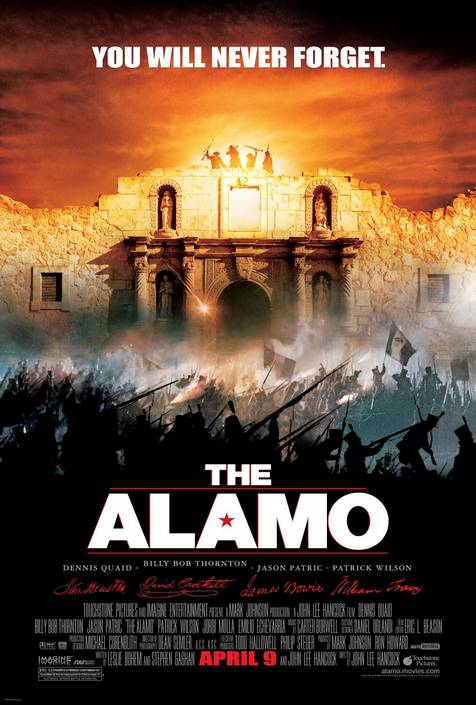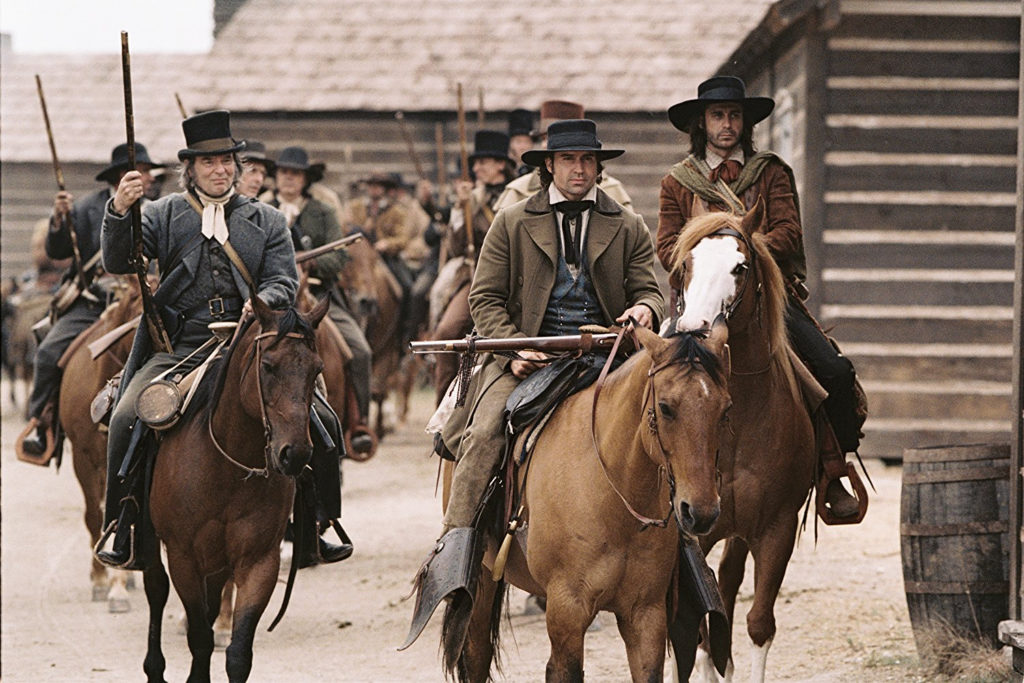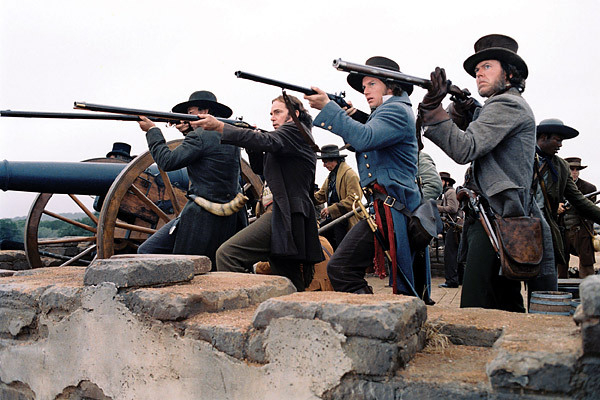For the 2004 Touchstone feature The Alamo, the Walt Disney Company once again tried to tell the tale of the defenders of the Alamo, and how they inspired the people of Texas in their fight for independence from Mexico. At one point this movie was a planned reuniting of Ron Howard and Russell Crowe, instead it was directed by John Lee Hancock, and starred Dennis Quaid.
To commemorate the anniversary of the battle of the Alamo, it’s time to take a look at how Disney told the Alamo story, and how different it was from the Fess Parker version in 1955. History will be recreated, and a lot of money will be spent, with no profit to be made. It’s time for an honest review of The Alamo.
The movie starts off with narrative text, telling viewers the history of the Alamo, and how its true purpose of being a Spanish mission never was fulfilled. Due to its location, the Alamo mission was defended and held by armies from many sides, it was at a crossroads of siege and battle.
Viewers get to see what the Alamo will become, a slaughterhouse, as bodies from recognizable stars like Stuart Wilson are hauled around by Mexican soldiers and buried. This is a place of death. But the story zips back a year to when Sam Houston, meets David Crockett. In this movie, there is no ballad about the legendary Crockett. He’s not even Davy, but David.
Dennis Quaid’s Sam Houston and Billy Bob Thornton’s David Crockett look like, talk like, and act like regular guys, who happen to be politicians. Houston is trying to convince Americans to come to Texas, but no one seems to care. Then the film does something you wouldn’t expect it to do. It comments on how outlandish the legend of David Crockett is, even in his own time. An actor dressed in buckskin clothing and a coonskin cap is putting on a performance taking on the legendary role, and during the performance he acknowledges that the real David Crockett is in the audience. The differences between the two are astounding, Thornton is the real person while the exploits are enhanced and embellished to make an entertaining show. The tall tales of David Crockett did not get invented in the 1950’s with Walt Disney, but rather started from Crockett’s own time.
From the halls of Washington to the flat lands of Texas, we move the story to the battle for independence from Mexico. Finally Sam Houston is amongst the settlers, both American and Mexican who desire freedom from an oppressive tyrant like the leader of Mexico, General Santa Anna. It is here in Texas that we meet the rest of our actors who will play a decisive role in the birth of the lone star state.
Jason Patric plays Jim Bowie, a legendary figure himself who everyone seems to listen to, whether they like him or not. Houston is almost removed from command of the Texas army, until Bowie walks in and gives his support. Then again, it could be the massive knife that he removes and stabs into a table that scares everyone into obedience.
The final main character to be introduced is William Travis. He is a Lieutenant Colonel in the Texas army, divorcing his wife, and leaving his son in the care of a trusted family, while he goes to serve at the Alamo. Only during the 1800’s could you just leave your child with anyone in the community and not get in trouble. But Travis has a problem, Bowie does not like him. As the story is developed, the Texans have taken back control of the Alamo and Santa Anna and his army, seem like a distant threat. He isn’t, and the tension will build soon.
The action for the rest of the movie shifts between San Antonio and the Alamo, and Houston’s drive to build an army that can defeat Santa Anna. In San Antonio, we see Bowie come home to where he once lived, touring through the wreck of his house, remembering when his wife was alive. But even though Jim Bowie is alive, he has lost all will to live. Perhaps that is why he seems so willing to pick deadly fights with anyone at the start of the movie.
For William Travis, he is placed in command of the Alamo unexpectedly and forced to work with Bowie and his militia soldiers, who are loyal to Bowie. The tension that builds between these two is quick, and understandable. They are very different men, and it is only through restraint that their bitterness is only expressed in words. Citizens of San Antonio are on edge, but to David Crockett, who rides into town with friends, he believes it’s a place to retire after losing the latest congressional election. When confronted by one of the militia members, who says that he doubts Santa Anna will show his face now that Davy Crockett is here, Thornton does a masterful job of trying to fulfill everyone’s expectations of who David Crockett is, but his response is priceless. With concern, and a momentary flash of terror, “I thought the fighting was over,” Crockett says and you have to wonder if he was thinking, what did I just walk into?
The battle for command of the Alamo plays out for much of the story until Santa Anna and his army arrive. Crockett is offered command as a compromise, but he states that he is with them and not above them. Similar storylines like the 1955 Davy Crockett at the Alamo show how much people trust Crockett, but his decline for command shows his true character. Despite the hype about the man and the legendary stories of what he may have accomplished, David Crockett is a humble man, or perhaps scared.
Santa Anna’s approaching army forces the citizens of San Antonio to flee to the walls of the Alamo. The major difference in 2004’s movie and what Fess Parker experienced in the 1955 movie is that women and children, white and Latino were a part of the backdrop. This is not a story about Caucasian men. That is something that was truly missed in the 1955 Disneyland television movie. The true tale of the Alamo is about a variety of people who come from mixed backgrounds.
By the time Santa Anna surrounds the Alamo, the inevitable will soon happen. Through sporadic moments of battle, soldiers are killed on all sides, until finally Santa Anna with supremacy in numbers, storms the Alamo and slaughters the defenders. The men at the Alamo die, and the horror of Santa Anna’s deeds inspire the Texan army led by Houston.
Houston forces Santa Anna to divide his force and chase after him. Finally Houston learns of a smaller force led by Santa Anna at the nearby San Jacinto River, and attacks. Eighteen minutes later Santa Anna is captured, the battle is over, and Houston bargains with the general. Texas independence for his life. The war is over, and Sam Houston will become the new nation’s President. The men who died at the Alamo will forever be remembered.
Final Thoughts
I really liked this movie. Not only does it capture the struggle of the Alamo, and the people who fought there, John Lee Hancock tells a story that evolves from the battle of the Alamo and the consequences of the peoples sacrifice in San Antonio.
Dennis Quaid is a great Sam Houston. It’s hard to not like and dislike Houston at many points throughout the movie. He seems both the slimy politician that is trying to enrich himself, to a military genius that bides his time until victory is possible.
Billy Bob Thornton is spectacular as David Crockett. He is an average guy, who understands that there is an expectation of him, and tries to live up to those expectations. You can’t help but empathize with Crockett, as he tries to navigate the world where people believe that the actor they saw on stage was him. He arrives in Texas wearing the coonskin cap like the actor does in the show, but it quickly disappears. David Crockett is an elusive figure to history, where you have to separate the man from the myth. But how does Crockett obtain this myth.
We see through Thornton’s portrayal a man who has great skill. His shooting at Santa Anna and hitting him in the shoulder from a lengthy distance gives viewers a hint of how great a shot Crockett is. David Crockett was said in the 1950’s song as being a man who don’t know fear. When Crockett is asked to protect the most vulnerable wall at the Alamo, he hesitates, with Travis asking him if he preferred another assignment. Crockett`s response is that he was about to ask for that posting, but viewers have to wonder if that was really what he was thinking.
At one point late in the siege Crockett confides that if he was old David from Tennessee, he would slip over the wall and take his chances on his own, fleeing from the Mexican army. But people expect Davy Crockett to stay and fight; so he does. Unlike the 1950`s Davy Crockett at the Alamo, the real Crockett did not die swinging his rifle at the invading army. It is believed that Crockett was captured and executed following the battle. This movie shows the heroism of Crockett as he taunts Santa Anna, who expects him to beg for his life. Santa Anna does not get what he wants.
The Alamo was a box office disappointment. Costing over 100 million dollars to make, and only making a quarter of that back at the box office. The movie was ignored by audiences and savaged by critics. Many lambasted the film for putting a Disney spin on history. To those who say this movie is a Disney esque tale of history, I wonder if you really watched this movie.
In John Lee Hancock`s movie, we see the defenders of the Alamo as real people with real faults. It`s hard to like Jim Bowie. He seems like a psychopath that would snap at any minute. William Travis is a self-obsessed man who abandons his family, and David Crockett the hero of the past is really just an average guy who did some above average things in his life. Jim Bowie and William Travis were slave owners, and we actually see them with their slaves in the Alamo. At one point Bowie tells his slave to leave, to which the slave thinks he is being set free, but Bowie has other ideas. Bowie tells the man that he is his property and will be until the day he dies. Bowie plans to come find him later. A promise that Bowie cannot keep.
Travis` slave seeks shelter and practices his Spanish after Travis is killed. Right until the end, Travis kept the man right beside him, not caring for his well-being. David Crockett dies a hero through simple defiance, and feeling compelled to live up to everyone`s expectations. We see the brutality that the people at the Alamo experienced. The battle was quick when it came, because it was quick in real life.
Finally, we see a cast that is reflective of the real people involved helps The Alamo stand out for attempting to tell a real tale. Spanish is used in all communications between Santa Anna and his generals. Latino actors fill out the roles of the people who were actually living in Texas at the time. The Alamo was not filled with only white people like the 1955 Davy Crockett at the Alamo showed us.
The Alamo is a fantastic movie that dared to show the people who fought and died for Texas independence, with warts and all. They were alcoholics, slave owners, philanderers, and ordinary people. Yes, there are patriotic speeches that are ridiculous. Houston’s speech before the final battle at San Jacinto is not inspiring or long but symbolizes what the Alamo was for the people who fought for Texas independence; a call to battle. They fought hard, died young, and committed brutal acts. This is what history is filled with.
I love Marvel, Pixar, and Lucasfilm, but I hope to see more movies like The Alamo in the future. It’s time for Disney to mine American history and tell the true tales that are waiting to be told. Perhaps with the Fox acquisition this might be possible.




